Rail transport in Indonesia
The majority of Indonesia's railways are on Java, used for both passenger and freight transport. There are three noncontinuous railway networks in Sumatra (Aceh and North Sumatra; West Sumatra; South Sumatra and Lampung) with two new networks are being developed in Kalimantan and Sulawesi.[4][5] Indonesia has finalized its plan for a national railway network recently. According to the plan, 3,200 km of train tracks that will criss-cross the islands of Sumatra, Java, Kalimantan, and Sulawesi, it has been touted as the most extensive railway project in Indonesia since its independence from the Dutch in 1945.[6]
| Indonesia | |
|---|---|
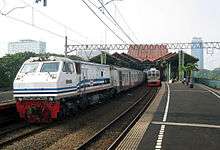 An inter-city and a commuter train at Gambir railway station. | |
| Operation | |
| National railway | Kereta Api Indonesia |
| Statistics | |
| Ridership | 21868.4 million (2015, as of October)[1] |
| Freight | 995.5 million tonnes (2015, as of October)[2] |
| System length | |
| Total | 5,042 kilometres (3,133 mi) [3] |
| Electrified | 411 kilometres (255 mi) |
| Track gauge | |
| Main | 3 ft 6 in (1,067 mm) |
| 1,435 mm (4 ft 8 1⁄2 in) | 107.7 kilometres (66.9 mi) |
| Electrification | |
| Main | 1.5 kV DC overhead line |
Urban railway exist in form of commuter rail in Jakarta, Bandung, and Surabaya. New mass rapid transit and light rail transit system are currently being introduced in Jakarta and Palembang.
Despite Indonesia has a left-hand running for roads, most of the railway lines use right-hand running due to Dutch influence.
Indonesia's rail gauge is 1,067 mm (3 ft 6 in), although 1,435 mm (4 ft 8 1⁄2 in) and 750 mm (2 ft 5 1⁄2 in) lines previously existed. Newer constructions in Aceh, Kalimantan, and Sulawesi, along with the Jakarta LRT, are using the 1,435 mm gauge. Most of the Jakarta metropolitan area is electrified at 1500 V DC overhead.
Indonesia's railways are operated by the state-owned Kereta Api Indonesia, its commuter subsidiary, the Kereta Commuter Indonesia, and the airport rail link subsidiary, the Railink (airport rail link). The infrastructure is state-owned, and companies pay a fee for using the railways.
Various narrow gauge industrial tramways operate in Java and Sumatra, serving the sugarcane and oil palm industries.
History

The first railway line in Indonesia opened in 1867. The railways were gradually expanded by both the state and private companies.
The Japanese occupation and the Indonesian War of Independence left Indonesia's railways in a poor condition. A batch of 100 steam locomotives were ordered in 1950, and dieselisation started in 1953. By the 1980s most mainline services had been dieselised. Electric multiple units were obtained from Japan beginning in the 1970s, replacing 60-year-old electric locomotives.
Since the independence era, all mainline railways in Indonesia have been managed by the state. The owners of the private railway were compensated first, but the system was fully nationalised in 1971.
Construction of new railway lines has been scarce, and most new construction is concentrated on double- and quad-tracking of existing railway lines. Most of the former tramway lines have been closed, reducing the mileage from about 7000 km to only 3000 km.
Rolling stock
Preserved locomotives
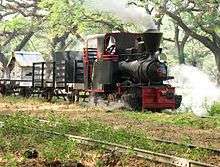
Indonesia had various types of locomotives, being the legacy of the many different companies. Surprisingly, only three steam locomotives remain in operable condition, all located in the Ambarawa Railway Museum. On the other hand, static steam locomotive displays are located in the Transportation Museum (under the auspices of the Department of Transportation) in Jakarta's Taman Mini Indonesia Indah (Beautiful Indonesia in Miniature Park) and Ambarawa Railway Museum (managed by PT Kereta Api) in Central Java. Plinthed locomotives can also be found in most cities and towns. Somewhat surprisingly, few non-locomotive rolling stock were preserved.
With the Asian economic crisis of 1997, remaining hulks of steam locomotives formerly standing in former depots became valuable for their scrap value, and by 2000, most locomotives not already plinthed or sent to museums were scrapped, presumably illegally.
Four operable industrial steam locomotives are present, with two more preserved, at the Cepu Forest Railway. This currently represents the largest concentration of active preserved steam locomotives in Indonesia.
Several "last" steam locomotives were built for Indonesia. E1060, a 1966-built rack steam locomotive (Esslingen 5316) is operable in Ambarawa railway museum. BB84, the last Mallet locomotive built for a non-tourist railway (according to Durrant) was built by Nippon Sharyo Keizo Kaisha in 1962 (works number 2007). This locomotive was plinthed in Banda Aceh and survived the December 2004 tsunami. The locomotive is in rather poor condition with its valve gear and cylinder pistons missing (as of March 2006).
Steam locomotive 1622 "Sri Gunung" (Mountain Queen), a 1,067 mm (3 ft 6 in) mallet built in 1928, preserved in the Dutch Railway Museum.
The Trangkil No. 4 (Hunslet 3902) was built in 1971, being the last steam locomotive built at Hunslet's Jack Lane Works in Leeds, England. The locomotive was used on the Trangkil sugar mill estate on Java. It has been repatriated to the UK in 2004.[7]
Diesel locomotives
As of 2016, PT Kereta Api operates about 350 units of diesel locomotives divided into classes in Java and Sumatra[8] used both for passenger and freight services. The first diesel locomotive owned by PT Kereta Api was CC200 class, built by General Electric in 1953.[9]
Electric trains
As of August 2017, PT Kereta Api's commuter subsidiary, Kereta Commuter Indonesia, operates 758 units of electric multiple units (EMU) in Greater Jakarta area.[10] Most EMUs operated in Jakarta are secondhand trains acquired from major urban railway operators in Greater Tokyo in Japan, such as East Japan Railway Company and Tokyo Metro.
Infrastructure
Railways on Java
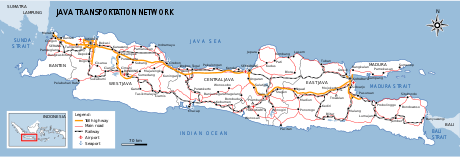
The first railways in Indonesia were built on the island of Java, using 1,435 mm (4 ft 8 1⁄2 in) gauge. During the Japanese occupation, they were converted to 1,067 mm (3 ft 6 in) gauge. At its greatest extent, the Javanese network had a length of 4,807 kilometres (2,987 mi), connecting most parts of the island.[11] The Javanese network train (in Java Island) is divided into nine operating divisions.
Railways on Sumatra
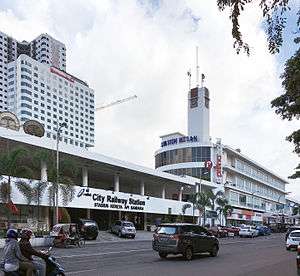
In Sumatra as of 2013, there are 1,869 kilometres of track, of which 1,348 km are operational.[12] Several unconnected railway networks were built in the time of the Dutch East Indies:
- Banda Aceh-Lhokseumawe-Besitang-Medan-Tebingtinggi-Pematang Siantar-Rantau Prapat in northern Sumatra (the Banda Aceh-Besitang section was closed in 1971, but is being rebuilt, as of 2011 [13])
- Padang-Solok-Bukittinggi in West Sumatra
- Bandar Lampung-Palembang-Lahat-Lubuk Linggau in southern Sumatra.
Plans to connect up and fix these isolated lines are included in the Trans-Sumatra Railway plan. Railway services in Sumatra by operational is divided into three regional divisions, which are:
| Regional Division 1 (North Sumatra and Aceh) |
Regional Division 2 (West Sumatra) |
Regional Division 3 (Palembang (South Sumatra)) |
Regional Division 4 (Tanjungkarang (Lampung) and partly South Sumatra) |
|---|---|---|---|
|
|
|
|
Railways on Kalimantan
In 2010, plans were announced for Kalimantan to get a 122 km long 1,435 mm (4 ft 8 1⁄2 in) standard gauge railway for the transport of coal between the Muara Wahau mine and the port of Bengalon.[14] In January 2016, Russian Railways reported that its construction of a railway in Kalimantan will finish in 2019. [15]
Railways on Bali
In 2019 it was reported in Gapura Bali that Wayan Koster, governor of Bali, "is keen to improve Bali's transportation infrastructure and is considering plans to build an electric rail network across the island".[16]
Railways on Sulawesi
The Trans-Sulawesi Railway is under construction, and will be built with 1,435 mm (4 ft 8 1⁄2 in) standard gauge which is wider than the 1,067 mm (3 ft 6 in) cape gauge used in Java and Sumatra to accommodate more weight and speed.[17][18]
Usage
Passenger services
PT Kereta Api Indonesia(Persero) provides extensive passenger services. Various classes are available, from "'Argo'" class with reclining seats and plane - like facilities, executive class with air conditioner and reclining seat comparable to the better classes of other countries' railways, business coaches which recently have been equipped with air conditioner and reclining seats much like executive class, to the hard bench, but still air conditioned economy class coaches for cheaper trains. In last couple of years, the business and economic class are in the process of being equipped with air conditioned system. The whole process was completed in early 2013.
Sleeper trains have existed in Indonesia. The last all-sleeper train service was Bima express train which ran from 1967 to 1984 when it was changed to mostly coach, leaving only one or two sleeping cars. It ran in this configuration until 1995, when the sleeper cars were withdrawn and modified into seating coach. Since 2018, sleeper trains have been re-activated for the Argo Bromo Anggrek (Jakarta to Surabaya), Taksaka (Jakarta to Yogyakarta), Argo Lawu and Argo Dwipangga (Jakarta to Solo), and Gajayana (Jakarta to Malang).[20]
In Java, most trains connect Jakarta and the hinterland - regional (or "cross-country" services) have not been fully developed. Between pairs of important cities such as Jakarta and Bandung, intensive hourly services are provided.
Most passenger trains in Indonesia, except commuter locals, are named. The names varies from plainly descriptive such as Depok Ekspress (a fast service between Jakarta and Depok), through Logawa (name of a river near Purwokerto, which is served by the train), Argo Lawu (Mt. Lawu, an extinct volcano near Solo, which is served by the said express train), to more or less meaningless, though romantic, names such as Bangunkarta (abbreviation of names of cities it serves: Jombang-Madiun-Jakarta) and Matarmaja (Malang-Blitar-Madiun-Jakarta).
Railway passenger services experienced a renaissance in the 1995-1999 period, with the introduction of many new passenger express services. With the advent of cheap airplane tickets, PT Kereta Api has experienced a downturn in the number of passengers carried, though the number has stabilized and most trains remain at more than 50% occupancy rate.
Argo Network

Note: K.A. Argo Gede no longer exists (and also K.A. Parahyangan). As a replacement, K.A. Argo Parahyangan trains operate the same routing as a merge of K.A. Argo Gede and K.A. Parahyangan.
Women only carriages
As a response to many reports of sexual harassment in public places, including commuter trains and buses, PT Kereta Api launched women-only carriages in some commuter trains in Jakarta metropolitan area in August 2010.[21] On May 13, 2013 PT KAI changed women-only trains to regular trains which at the front and back of the train has a coach for women only. This rule apply in KRL Jabodetabek.[22]
Priority seat
PT KAI designates priority seats to elderly passengers, pregnant women, disabled passengers and mother with infant to ride public transport with an equal degree of access and comfort as other people. This apply in KRL Jabodetabek. Priority seat not only in the first and end of the train like in women only carriages, but eight seats in each carriage are designated as priority seats.
Priority Class (Sleeper Train)
PT KAI relaunched the Sleeper Train service in June 11, 2018.[23][24] This sleeper train is equipped with excellent facilities even in the same class as a first class aircraft cabin. The first route for Sleeper Train is from Gambir Jakarta to Surabaya.[25] The operational of the Luxury Sleeper Train will be taken over by PT KA Tourism.
Freight services

The railway system in Java is more or less a passenger-oriented system, and there are few freight services, due to the limited capacity of the tracks. Some notable freight service in Java include the Kalimas container train and the Parcel train between Jakarta and Surabaya, petroleum trains between refineries or oil pipe terminals and oil depots, and quartz sand trains in Central Java.
But in recent years, there has been many efforts to increase freight traffic in Java by introducing the GE CC206 locomotives, as well as building double track lines that connect Jakarta and Surabaya on North Coast line to increase the number of container trains between both cities. Many container ports have also been built on intermediate cities and towns. This effort already attract some customers who normally shipped their products via roads.
The system in South Sumatra is rather freight-oriented. Coal unit trains, carrying coal for an electricity plant are given priority over passenger trains. In West Sumatra, the remaining railway line serves the cement plant at Indarung, near Padang, and in North Sumatra, several oil palm and rubber plantations are served by freight trains.
Urban rail and rail-based rapid transit
Greater Jakarta
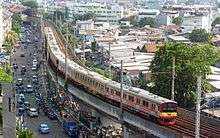
KRL Commuterline Jabodetabek is one of operational urban rail network in Indonesia, serving commuter routes in Greater Jakarta which comprises cities of DKI Jakarta, Depok, Bogor, Bekasi, Tangerang, and South Tangerang as well as regencies of Bogor, Bekasi, and Lebak. The other operational urban rail network are Jakarta MRT, Jakarta LRT, and an airport rail link to support the public transport network in the area.
Greater Surabaya
Regional rail functions as commuter rail in Surabaya, so technically there is no urban rail network. However, there are plans for a mass rapid transit network in and around Surabaya.[26] A 32 km diesel line from Mojokerto to Sidoarjo has been put into service, with 6 daily return trips.
Palembang
Palembang Light Rail Transit had operate in June 2018, before the 2018 Asian Games.[27]
Medan
Medan has Kualanamu Airport Rail Link transport which linking Kualanamu International Airport to Medan station and vice versa.
High-speed rail

In recent decades, Javan transportation backbones — north coast road and railway system that serves Jakarta-Surabaya corridor, has suffered greatly from both freight and passenger congestion.[28] The plan to build a high-speed railway system in Java has been around for many years. However, it was not until 2008 that the idea had been contemplated seriously. It was Japan International Cooperation Agency's proposal that initiated the idea to build high-speed rail for the Indonesian island of Java, linking up the densely populated corridor from the capital Jakarta to Surabaya city (covering 730 km) in East Java.[29][30] Japan is eager to export their Shinkansen high-speed rail technology abroad. Following up JICA's initial study in 2012, the detailed feasibility study was concluded in 2014. In recent years, Indonesia has been undergoing a revival in railway expansion and upgrades. The high-speed rail corridors have been proposed but not implemented yet, since it was deemed too costly.
In April 2015, China had entered the race with a counter-offer to build the Jakarta-Bandung high-speed rail in Indonesia.[31] A bid which alarmed Japan that has been nurtured the idea for years.
In July 2015, the Indonesian government announced their plan to build the high-speed rail system connecting Jakarta and Bandung, and devised a competition between Japan and China train-makers as potential bidders. Japan and China had expressed their interest in the project; both countries have done comprehensive studies of the project.[32]
In late September 2015, Indonesia awards this multibillion-dollar railway project to China over Japan.[33][34]
The proposed high-speed rail will connect the nation's capital Jakarta with Bandung city in neighboring West Java province, covering a distance of 150 kilometers, and is also expected to expand further, connecting to Indonesia's second largest city, Surabaya in East Java.[32] The project is scheduled to commence in late 2015, and is expected to open its operations to public by 2019.[35]
In December 2015 discussion for the Jakarta-Surabaya high-speed rail was commenced by the Indonesian Coordinating Minister of Maritime and Resources. Academicians from two major universities in Indonesia, and employees from Japan International Cooperation Agency, were invited to attend the discussion.[36][37]
Ticket and Payment Method
For Long Distance Train (by PT KAI)
To buy ticket for long distance train by PT KAI (traveling around Java Island), passenger can go to the official site of PT KAI.
For Urban Train (Commuter)
To buy ticket for commuter in Jakarta or Jabodetabek area, there are three types of tickets (for KRL user).
- Daily tickets (Indonesian: tiket harian berjaminan, abbreviated THB) can be bought by passengers at ticket counters or in vending machines. The ticket is for one trip only.
- Multi-trip tickets in Indonesia are called kartu multi trip (KMT). The tickets can be bought in a ticket locket. The ticket is for multiple trips.
- Ticket using bank card money (electronic money). The banks which have license for issuing the electronic cards are bank BRI with BRIZZI cards, bank BCA the card called Flazz, bank BNI the card called Tap Cash, and bank Mandiri the card called e-money. The ticket is for multiple trips, but the card first has to register for commuter train by simply tap the card in the red-box in the station area. These electronic money cards also can be used for paying busway fares and paying highway tickets.
To use the card, passenger taps the card in the automatic fare gate when first entering the station and taps again when leaving the destination station.
See also
| Wikimedia Commons has media related to Rail transport in Indonesia. |
References
- "Badan Pusat Statistik". wayback.archive-it.org. Archived from the original on 2015-11-13.
- http://www.bps.go.id/linkTabelStatis/view/id/1416%5B%5D
- Mohammad, Yandi (30 September 2015). "Jalur kereta yang kian menyusut". https://beritagar.id/. External link in
|website=(help) - Post, The Jakarta. "Central Kalimantan's $2.8b coal railway to kick off early next year". The Jakarta Post.
- "Jokowi promises more funding for Trans-Sulawesi rail project". www.thejakartapost.com. Retrieved 2015-12-28.
- "Indonesia's national rail network aims for more growth, less inequality". The Strait Times. Retrieved 8 September 2017.
- "Trangkil No.4". Statfold Barn Railway. Archived from the original on 18 March 2015. Retrieved 30 September 2015.
- Media, Kompas Cyber. "KAI dan GE Teken Kerja Sama Pemeliharaan Lokomotif Selama Delapan Tahun". KOMPAS.com.
- "Archived copy". Archived from the original on 2017-12-10. Retrieved 2017-12-17.CS1 maint: archived copy as title (link)
- Situs Resmi PT Kereta Commuter Indonesia
- Black, John (2016). "3. National Railway System". In Loo, Becky P. Y.; Comtois, Claude (eds.). Sustainable Railway Futures. Routledge. p. 42. ISBN 9781409452430.
- Media, Kompas Cyber. "Pemerintah Bangun Jalur KA Trans Sumatra Mulai 2014". KOMPAS.com.
- "Archived copy". Archived from the original on 2011-11-14. Retrieved 2012-03-20.CS1 maint: archived copy as title (link)
- Railway Gazette International November 2010, p56
- "RZD to finish building Kalimantan railway in 2019". 12 January 2016. Retrieved 5 June 2019.
- "All aboard! Is an electric rail network in Bali feasible?". Gapura Bali. 22 May 2019. Retrieved 5 June 2019.
- "Proyek Kereta Api Sulawesi Lebih Cepat dari Jawa". Tribun Jateng (in Indonesian). 24 October 2016. Retrieved 11 April 2018.
- Bintang, Amri (30 November 2017). "Buatan PT INKA! Inilah Kereta Inspeksi Trans Sulawesi Milik Kemenhub". KAORI Nusantara (in Indonesian). Retrieved 11 April 2018.
- "Papua railway, on the priority list of projects". Railway Pro. 17 February 2016. Retrieved 13 July 2019.
- Media, Kompas Cyber. "Kereta "Sleeper" Beroperasi Besok, Harga Tiket Promo Rp 900.000". KOMPAS.com.
- Indonesia Railway Company Launches Women-Only Carriages Archived 2010-08-21 at the Wayback Machine
- "Dahlan: yang dihapus kereta khusus wanita, bukan gerbong". May 15, 2013.
- Media, Kompas Cyber. "Luxury Sleeper Train Mulai Beroperasi, Ini Harga Promonya". KOMPAS.com (in Indonesian). Retrieved 2019-03-20.
- Exist, Exist In. "Kereta First Class Hadir di RI, Harga Tiket Rp 900.000". news. Retrieved 2019-03-20.
- "KAI121 on Instagram: "Bisa senyaman inikah kamu menikmati perjalanan #Mudik2018? Bisa dong! Dapatkan tiket KA #ArgoBromoAnggrekLuxury #SleeperTrain rute Gambir-…"". Instagram. Retrieved 2019-03-20.
- Post, The Jakarta. "Railway line to connect airport with downtown Surabaya". The Jakarta Post.
- Siregar, Raja Adil (20 May 2017). "Menhub Tinjau LRT Palembang, Pastikan Rampung Sebelum Asian Games". detikfinance. Retrieved 22 May 2017.
- Zakir Hussain, The Straits Times/ANN (28 October 2013). "Jakarta mulls high-speed rail system". The Jakarta Post. Jakarta.
- "Java High Speed Railway Development Project (Phase I)". Japan International Cooperation Agency. 2010. Retrieved 1 October 2015.
- Robin Harding in Tokyo, Avantika Chilkoti in Jakarta and Tom Mitchell in Beijing (1 October 2015). "Japan cries foul after Indonesia awards rail contract to China". Financial Times. Retrieved 1 October 2015.
- "Japan loses Indonesian high-speed railway contract to China". The Japan Times. 30 September 2015. Retrieved 1 October 2015.
- "INDONESIA PRESS-Govt to hold "beauty contest" for high-speed train project - Jakarta Globe". Daily Mail. 14 July 2015. Retrieved 1 October 2015.
- "Indonesia to award fast train contract to China - Japanese embassy official". Reuters. 29 September 2015. Retrieved 1 October 2015.
- "Indonesia awards multi-billion-dollar railway project to China over Japan". ABC. 30 September 2015. Retrieved 1 October 2015.
- Ben Otto and Anita Rachman (30 September 2015). "Indonesia's Handling of High-Speed Train Project Adds to Business Confusion, Mixed messages to Japan, China come as Indonesia courts foreign investors". The Wall Street Journal. Retrieved 1 October 2015.
- Ardan Adhi Chandra - detikFinance (2017-09-12). "Mengintip Kajian Rute Kereta Kencang Jakarta-Surabaya". Finance.detik.com. Retrieved 2019-03-20.
- S, Ari (20 October 2016). "Dengan Kereta Kencang, Jakarta-Surabaya Cuma 4 Jam".
Sources
- United States Central Intelligence Agency (June 2, 2005), The World Fact Book: Indonesia. Retrieved June 17, 2005.
- Garratt, Colin. The World Encyclopedia of Locomotives Anness Publishing (London), 2003, p. 47.
- History of Railways in Indonesia
Further reading
- How the Railroad is Modernising Asia, The Advertiser, Adelaide, S. Australia, 22 March 1913. N.B.: The article is of approx. 1,500 words, covering approx. a dozen Asian countries.
External links
- PT Kereta Api Indonesia (Indonesian Railways) Website (Indonesia)
- Railways Info (Indonesia)
- Jabotabek Train Website
- Jakarta Commuter Railways Routes and Schedules (Indonesia)
- Maps of Indonesian Railway Network (Indonesia)
- Steam Railway Photographs - Indonesia
